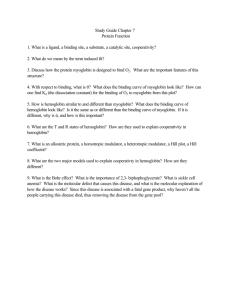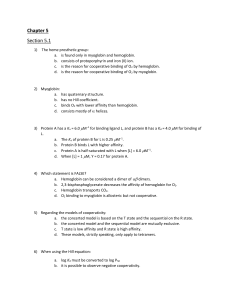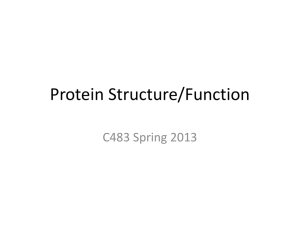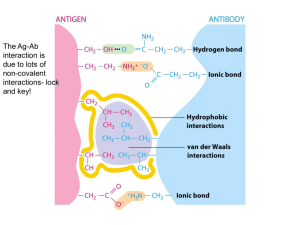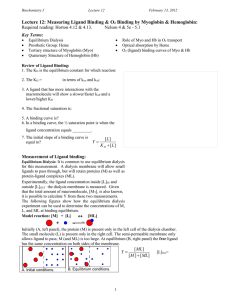Hemoglobin, an Allosteric Protein Stryer Short Course
advertisement
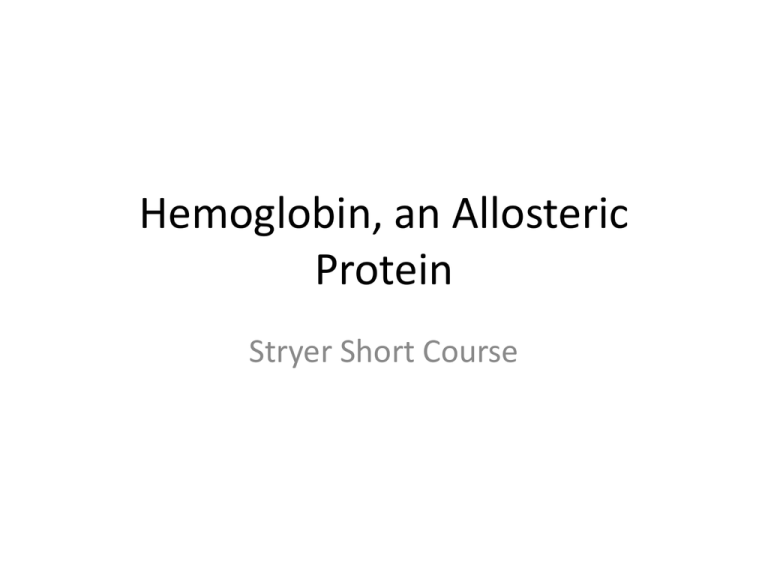
Hemoglobin, an Allosteric Protein Stryer Short Course Case Study: Hemoglobin • Structure: Quaternary, heme group • Function: Oxygen binding • Physiology: oxygen delivery from lungs to tissue • Myoglobin: no quaternary structure; stores oxygen in muscle tissue Oxygen Binding Curves • Fractional saturation • Partial pressure of oxygen – 176 torr, 100 torr in lungs with water vappr • Rectangular hyperbola vs. sigmoidal – cooperativity Physiological impact • Myoglobin is halfsaturated at 2 torr • Hemoglobin is halfsaturated at 26 torr O2 • Hemoglobin has less affinity for oxygen • Hb saturated in lungs • When it reaches tissues, oxygen is released • Steep in important region Structure of Myoglobin Structure of Myoglobin • Noncovalent binding in hydrophobic pocket • His F8 (proximal); His E7 (distal) • With oxygen bound, iron fits in porphyrin ring Functional MRI • MRI = NMR: detects water protons • Oxygenated hemoglobin has different magnetic qualities • Can detect “active” sites of brain, where oxygenated blood is being used Reversible Oxygen Binding • Tight hydrophobic pocket • Fe+1 easily oxidized outside of globin • Distal histidine and hydrophobic pocket limits Fe+3 formation Structure of Hemoglobin • • • • Oligomer of four units resembling Mb a2b2 tetramer Treated as dimer of ab units Hollow core in center Cooperativity • Binding of Oxygen changes shape of unit • Shape of subunit affects shapes of other subunits – Oxygen-bound unit causes other subunits to become relaxed – The rich become richer – Cooperative binding Allosteric Regulation • 2,3-BPG binds in central cavity, but only to T • Holds all subunits toward the “Tight” conformation • Disfavors oxygen binding Physiological Role of 2,3-BPG • Without 2,3-BPG, hemoglobin curve becomes hyperbolic • No 2,3-BPG leads to too great affinity • Hb would only deliver 8% of its oxygen • Fetal Hb doesn’t bind BPG; has greater oxygen affinity Problem • Fetal Hb is an a2g2 protein. At birth, adult Hb is produced so that by 6 months, 98% of the baby’s Hb is adult. In the graph, which is the binding curve for fetal Hb? What is the physiological purpose? Bohr Effect • pH affects oxygen binding • Lower pH in tissue leads to protonation of Hb • Ion pairs form in central cavity that stabilize the deoxy (tense) form • 77% of O2 released in acidic tissue Hb.H+ + O2 Hb.O2 + H+ Effect of Carbon Dioxide • CO2 produced in tissues also contributes to release of O2 • Reacts in cavity; makes salt bridges that stabilize deoxy form • Now 88% released Physiology • In tissue, CO2 produced; H+ concentration raised • decrease oxygen affinity in tissue compared to lungs • Protons, CO2 shuttled to lungs on Hb – minor process—mostly returns to lungs in blood buffer Problem • Propose a few explanations of how a KN mutation of a residue in the central cavity could lead to a mutant Hb with greater oxygen binding affinity. Problem • Propose a few explanations of how a KN mutation of a residue in the central cavity could lead to a mutant Hb with greater oxygen binding affinity. • It might change the conformation of the Fhelix such that His F8 binds oxygen better • Since the central cavity is less +, BPG might bind worse, favoring R • It might destabilize ion pairs that normally stabilize the T state Pathologies • Sickle-cell anemia • Thalassemia Sickle-cell Anemia • DV mutation – HbS • Hydrophobic effect in deoxy state • Leads to aggregate fibrils that distort the cell and block blood vessels Thalassemia • Loss of inadequate • b-thalassemia: tetramer production of one chain is all a form – Precipitates, kills cell • a-thalassemia: tetramer – Transfusions needed is all b form – Called Hemoglobin H (HbH) – No cooperativity – oxygen affinity too high – Usually fatal
